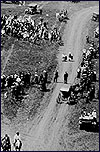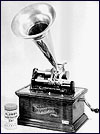 |
|
|
|
| ||
|
| ||||
 White Earth Celebration - MHS
 Columbia Graphophone - MHS |
| AT THE TURN OF THE CENTURY, the Smithsonian Institution's Bureau of American Ethnology was the apex of American anthropology. Frances Densmore first wrote to the Smithsonian in 1903-probably at Alice Fletcher's urging-to see if the BAE would cover expenses for her field work. The Bureau declined. Densmore pushed ahead with her research and writing.9 In the summer of 1906, Densmore did her first serious work on Indian music with the active cooperation of Indians themselves. She attended ceremonies on the White Earth Ojibwe and Prairie Island Dakota reservations. The following summer she started using a device that would distinguish her career as an ethnologist: the phonograph machine. On July 4, 1907, Frances Densmore and her sister Margaret watched the Red Lake Band of Ojibwe celebrate Independence Day. She persuaded a music store owner in Detroit Lakes to loan her an Edison home phonograph recording machine. She recorded an Ojibwe singer named Kitchimakwa (Big Bear). It would be the first of many thousand such sessions. Densmore got the idea of cylinder recordings from Fletcher's work, but Densmore became the more prolific recordist. Densmore wrote to Washington again, asking William Holmes of the BAE for money to continue her field work and mentioning the cylinder recordings. That hooked the legendary ethnologist. Holmes granted Densmore $350. She used it to buy her own cylinder machine with a steel "morning glory" horn that served both as microphone and speaker. Densmore would use this and similar machines for the next 30 years.10 | ||